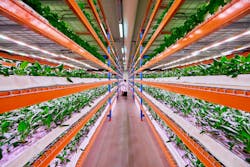World’s largest vertical farm serving greens from the desert
As far as we can tell, Signify, like some other lighting and LED vendors, is experiencing a slowdown in the horticultural sector. But the long-term prospects could be good, and the company continues to think big.
Case in point: It recently provided a photographic glimpse into what it says is the world’s largest vertical farm.
The all-indoor, artificially lit Bustanica vertical farm next to Dubai’s Al Maktoum International Airport at Dubai World Central has a growth surface of 30,000 square meters (about 330,000 square feet), or 3 hectares, more than any other indoor facility on the planet, Signify claims (please shout if you know of a bigger one).
Bustanica began operations last July and can produce a million kilograms of leafy greens annually, a Signify spokesperson said.
Indoor growing, out of the sun, is regarded by some experts as vital to help ensure food supplies around the world. Tuning artificial LED lighting to optimal frequencies for the desired crop, in climate controlled environments, can extend growing seasons in winter and boost growth possibilities in desert climates, such as in Dubai.
So where does Bustanica’s bountiful lettuce, kale, and spinach go?
The answer to that is to a large extent — literally — up in the air.
Bustanica is owned by Emirates Crop One, a joint venture between Dubai’s Emirates Flight Catering and Millis, Mass.–based vertical farm specialist Crop One. Emirates Flight Catering provides meals to about 100 airlines including Emirates airlines, of which it is part; both belong to the Emirates Group, owned by the government of Dubai, which is one of the seven entities of the United Arab Emirates.
By its own account, Emirates Flight Catering makes about 200,000 meals per day, supplying not just airlines but also restaurants and lounges at the Al Maktoum International and Dubai International airports, as well as private jets and events.
The 30,000 square meters rises up in 6 racks across a footprint of approximately 50 × 150 meters (164 × 492 feet) in a building that is approximately 18 meters (59 feet) high, Signify told LEDs Magazine.
"We have 27 controlled environments; with the right controls and the right lighting we can then grow whatever we require to grow in the most efficient and effective way," says Kieran Dowd, vice president of sourcing solutions for Emirates Flight Catering, speaking in a Signify video.
He gave ample credit to the Philips brand LED grow lights, supplied by Signify, noting that they are "specifically tailored to the plants that we’re growing," which allows them to "grow to their optimum nutritious best."
Meanwhile, on a different sort of growth front, Signify’s horticultural business appears to be generally stalling, at least for the moment. After its third-quarter 2022 ended, Signify CEO Eric Rondolat told analysts that horticulture had slowed, as growers could not afford the upfront cost of LED lighting, even though that lighting would save on significant energy costs.
When Rondolat reported fourth-quarter results two weeks ago, he did not issue a horticultural update. Signify has since declined to provide LEDs with one, leaving us with the impression that the slowdown continues. Signify division Fluence has noted that the important market for cannabis lighting has stalled. Last week, ams Osram noted that sales of LEDs to the horticultural sector continue to slump. Not too long ago, one well regarded Pittsburgh vertical farm closed its doors, turning off some 27,000 horticutural lighting fixtures from Current.
But things could pick up again for what had been a solid growth industry. There is plenty of optimism. Canadian horticultural lighting specialist Sollum Technologies recently received a fresh round of venture investment.
In Dubai, Bustanica is certainly expressing a bright outlook.
"We’ve now got chefs coming back to us and asking us what else can we grow," said Dowd of Emirates Flight Catering.
The time could be approaching when horticulture takes off again.
MARK HALPER is a contributing editor for LEDs Magazine, and an energy, technology, and business journalist ([email protected]).
For up-to-the-minute LED and SSL updates, follow us on Twitter. You’ll find curated content and commentary, as well as information on industry events, webcasts, and surveys on our LinkedIn page and our Facebook page.

Mark Halper | Contributing Editor, LEDs Magazine, and Business/Energy/Technology Journalist
Mark Halper is a freelance business, technology, and science journalist who covers everything from media moguls to subatomic particles. Halper has written from locations around the world for TIME Magazine, Fortune, Forbes, the New York Times, the Financial Times, the Guardian, CBS, Wired, and many others. A US citizen living in Britain, he cut his journalism teeth cutting and pasting copy for an English-language daily newspaper in Mexico City. Halper has a BA in history from Cornell University.







